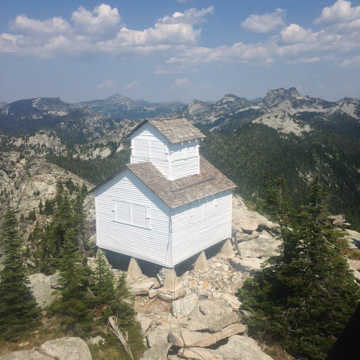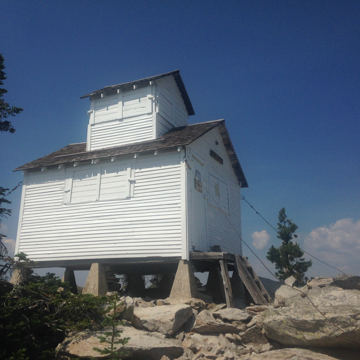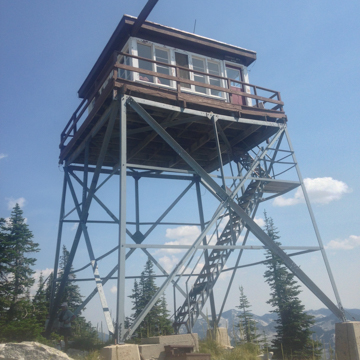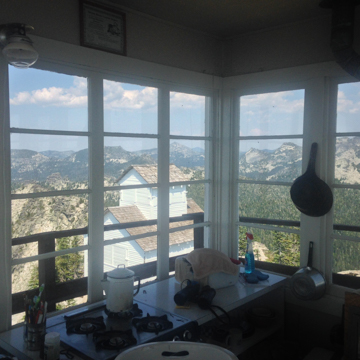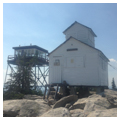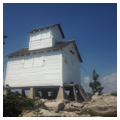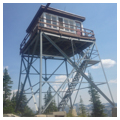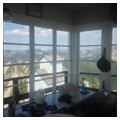In the wake of the infamous forest fires in August 1910, which consumed over three million acres of virgin timber in the northern Idaho Panhandle and western Montana, the fledgling U.S. Forest Service (USFS) established a comprehensive system for fire detection and prevention using fire lookouts as the front line of defense. Over nine hundred lookouts were constructed throughout Idaho during a concerted effort by the USFS to place a pair of eyes on every major mountain top overlooking their vast holdings. Among the approximately 165 lookouts that remain in the state, the 1929 structure on Lookout Mountain in the North Idaho Panhandle’s Selkirk Range is a carefully restored relic of early forest service lookouts; the cupola-style structure represents the only remaining example of this early USFS design in Idaho. Directly beside it, a lookout built in 1977 from recycled portions of an abandoned forest service lookout, remains in active use. Together, they help tell the story of lookout development in the Intermountain West.
Fire lookout design, construction, and human habitation presented many challenges, given the need to locate the towers in remote areas in inhospitable environments at high elevations. Such is the case with the sequence of lookouts on Lookout Mountain. The steeply sided granite summit, which has served as a fire watch point since 1921, is accessed via a 3.5 mile hiking trail leading from a steeply ascending four-wheel drive road. The natural vantage point affords panoramic views of the Selkirk Range and forested mountains that form the Priest Lake basin and the corresponding western portion of the USFS’s Region One. By necessity, the earliest lookouts were constructed in co-opted tree snags or with materials gathered on site. The first shelter to house fire watchers on Lookout Mountain may have been a simple log cabin, though evidence of this early structure has not been confirmed. In 1929, the first permanent lookout was constructed as a “cupola style” cabin using pre-cut conventional lumber framing and lap siding; all construction materials were transported to the site by mule. The “fire-finder” lived in the cabin and regularly climbed into the cupola above the living quarters for observational purposes.
According to fire lookout preservationist Gary Weber, fire watch capacity at the Lookout Mountain site was enhanced in 1939 with the addition of a 50-foot-tall, heavy timber tower capped by a USFS “L-4” design lookout house. Clyde Fickes, supervising architect for Region 1 of the USFS, developed several lookout designs for Region 1, including the L-4. Among his designs, the L-4 lookout house was widely adopted by other USFS regions throughout the northwest between 1929 and 1953. The L-4, also known as the “Aladdin,” consisted of a 14 x 14– foot cabin framed with pre-cut dimensional lumber, windows on every elevation, and capped with a gable end or hipped roof. Wood shutters were mounted horizontally as overhangs to provide shade for the window wall during summer months and lowered to cover the windows and help seal the structure during the winter. The L-4 could be sited at ground level or raised on wooden towers up to 60 feet in height. Civilian Conservation Corps crews constructed the pack trail used by mule trains to deliver construction materials to the site and assisted with tower assembly. When the USFS closed Lookout Mountain as a fire watch site in 1947, the 1939 L-4 tower was abandoned. Due to harsh mountain weather conditions, and lack of maintenance, the tower collapsed circa 1965.
The Idaho Department of Lands re-opened Lookout Mountain as an active fire detection site in 1977 and erected a tower salvaged from another lookout site. The lower 25-foot section of the steel was relocated from Pack Saddle Mountain. The lookout house or “cab” was built on-site; the cab was modeled after the “R-6” design which was developed by the USFS Region 6 in the 1950s. The R-6 remains in common use and features a 15 x 15–foot wood frame cabin with a flat, overhanging roof to provide shade for the window wall surround. Idaho Department of Lands employee, Pam Aunan, has been the principal fire watch at Lookout Mountain since the early 1980s, packing in her own supplies each fire season and embracing a lifestyle of isolation, alpine serenity, and the periodic intensity that surrounds the discovery of a new smoke plume.
Lookout Mountain’s 1929 cupola-style lookout is sustained by its uniqueness; the simple, but exquisite, structure was listed on the National Historic Lookout Register after volunteers from the Forest Fire Lookout Association (FFLA) carefully restored it between 1983 and 1992. Consistent with the earliest wooden towers throughout Idaho, natural elements have taken a toll, as evidenced by the total loss of the 1939 structure on Lookout Mountain. The 1977 steel lookout tower perseveres because it remains in active use. Among Idaho’s inventory, it represents one of approximately 50 structures that are regularly used for fire detection purposes. The future of remaining structures on Lookout Mountain, and others throughout Idaho, depends upon stewardship provided by volunteer groups such as the FFLA.
References
Grosvenor, J. A History of the Architecture of the USDA Forest Service. Washington DC: United States Department of Agriculture, 1999. Accessed on June 17, 2015. http://www.foresthistory.org/ASPNET/Publications/architecture/contents.htm.
Idaho Public Television. “Eyes of the Forest: Idaho’s Fire Lookouts.” Aired November 17, 2011. Film. Accessed February 15, 2015. http://idahoptv.org/outdoors/shows/eyesoftheforest/.
Idaho Public Television. “Forest Fire Lookout Association.” Eyes of the Forest, Idaho’s Fire Lookouts. Accessed June 10, 2015. http://idahoptv.org/outdoors/shows/eyesoftheforest/FFLassociation.cfm.
Idaho Public Television. “Lookout Mountain: Priest Lake.” Eyes of the Forest, Idaho’s Fire Lookouts. Accessed June 10, 2015. http://idahoptv.org/outdoors/shows/eyesoftheforest/lookoutMountainPriestLake.cfm.
Kamstra, Rex. “Idaho Forest Fire Lookout Tower Sites.” Forest Fire Lookout. Accessed March 14, 2015. http://www.firelookout.com/id.html.
Kamastra, Rex, Ray Kresek, and Bill Starr. “ www.firelookout.org/fire-lookout-types.html.
Kresek, Ray. Fire Lookouts of the Northwest. Fairfield, WA: Ye Galleon Press, 1984.
Schacher, Cindy. “Lookout Styles: Nez Perce National Forest.” U.S. Forest Service. Accessed on June 11, 2015. http://www.fs.usda.gov/Internet/FSE_DOCUMENTS/stelprdb5327500.pdf.
Weber, Gary. Email interview by Wendy R. McClure. February 12, 2015 and June 16, 2015.

